One of my favourite road movies is Steven Spielberg’s Duel (1971). It is about a middle-aged salesman driving his a red Plymouth Valiant on a lonesome road, and being pursued by an 18-wheel truck (the driver of which is never shown in the film) just because he makes the deadly mistake of overtaking it at one point rather than getting a lungful of diesel from its exhaust.
Motoring enthusiasts will appreciate Spielberg’s spiffy camerawork in this man versus machine movie, especially the shots from some really dynamic angles: the front and rear windshields of the car and the truck, the rearview mirrors, the extreme closeups of the speedometer needle. Thanks to the great use of handheld camera, viewers feel every jerk of the car and every bump along the road. And they feel they themselves are driving the car.
What Spielberg brought to the big screen is something people experience every single day on Indian roads. Every day, drivers in India go about dodging, honking, manoeuvring and saving themselves from being rear-ended. It is exactly why writer Jeremy Clarkson calls Indian roads a “war zone” and driving on them “the most dangerous game on earth”. He says driving in India is “chaos theory on wheels, where most of the participants aren’t trained”.
It is a sentiment shared by Kevin Flynn, president and managing director of Fiat Chrysler Automobiles India. The London-born Flynn is still coming to grips with what goes on Indian roads. He finds it staggering that “the traffic actually flows and moves and that there is a system in there”. “It is amazing how, when people are on the motorway and they need to get back to a junction on the motorway, they don’t think anything about driving up the hard shoulder the wrong way,” he says.
Meet Behzad Gazder, a Mumbai-based advertising professional who is passionate about cars and bikes. “My wife and I love driving, but both of us have distinctively different driving styles. While she drives her Chevrolet Cruze Ultra carefully over bumps, I like to go flat out in my Volkswagen Polo 1.2 TDI as if I am in a rally. She can’t stand my driving style and I hers, and that is mainly because everybody in India thinks they are perfect drivers. But, that is far from the truth, as nobody in India is taught how to drive, as there is no real ‘Driver’s Ed’,” says Gazder, who just took the keys from his driver one day and learnt to drive on his own.
According to him, driving cars in India makes you so fearless that you can drive in any part of the world and even consider an alternate career as a race car driver. He recently drove a Fiat 500 across Spain and a Kia Sorento V6 and Dodge Viper in the US after a crash course in driving.
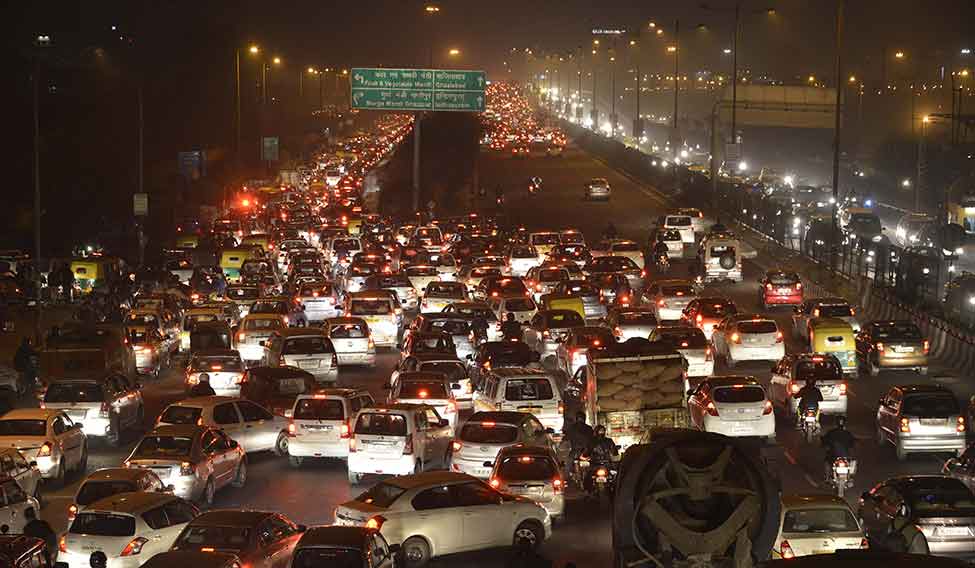 Chock-a-block: A scene from NH 24 in Delhi | Arvind Jain
Chock-a-block: A scene from NH 24 in Delhi | Arvind Jain
If Gazder went abroad and drove amid disciplined traffic, Joe King, head of Audi India, went through the whole rigmarole of acquiring an Indian driving licence just so he could drive in India. As somebody who enjoys driving tremendously, King drives around his Audi A8 and Audi Q7 over weekends. For a foreigner, he was quick to discern the driving style of Indians. “There is a tremendously ambitious culture in India,” says King. “Everyone wants to get ahead; but on road, it doesn’t manifest itself into easing the traffic. When a five-lane turns into a three-lane because of construction or whatever, people start ducking around just to get two cars ahead. That is what slows all process down. If everyone just took their time and allowed traffic to flow, everybody would get there a lot quicker.”
A few years ago, an American friend of mine who was visiting India for the first time simply could not fathom how Indians drove with both their wing mirrors shut. Imagine her surprise when she saw animals on roads—from street dogs to cows and bullocks, and the rare elephant and horse.
Says Roland Folger, managing director of Mercedes-Benz India: “You have way too many participants in your traffic with significantly different driving speeds. So, you have, on the same highway, your AMG car and your normal car, and it goes down to the guy pushing his frame of goods that he wants to sell, and they are all on the same highway! So, of course, it slows down traffic that could go tremendously faster.”
If you want to drive in India, you may want to master the ‘Indian highway code’. What is it? Flick to the left suddenly, even if there is no looming threat from another motorist. Then, a few metres later, do the same thing again—only this time, flick to the right. When you see a sacred cow, instead of dodging it, roll down your window and try to fleetingly touch it as if seeking its blessings. Cut people off the minute you see them doing 20kmph on the fast lane. Do it by getting menacingly close, giving them angry looks and demonstrating your overtaking skills, which you have perfected in all your years of driving at 120kmph. Catch them totally unawares.
Also, do not forget that your mission is to keep trying to get ahead of every driver, who is also trying to get ahead of every driver. These days, you do not think twice about rolling down your window and giving others the finger; but be prepared, because the courtesy might be returned instantly—even before your turbo kicks in and you speed away. If you are not going to adhere to this code, you haven’t ‘arrived’ in India.
The range of Indian drivers spans from ‘aunty drivers’ (the cautious ones who do 20kmph on the fast lane) to the ‘hero drivers’ (the overconfident who groom themselves while driving). Bob Rupani, consulting editor of Overdrive Media, who has driven 1.5 million kilometres on Indian roads, recalls a funny incident. “I had this driver who, every five minutes, would turn the rearview mirror towards him to comb his hair,” he says. “When I asked him what was going on, he said, ‘Hindi film mein driver bade handsome hote hain; to mein bhi apne aap ko tip-top hi rakhta hoon [The drivers in Hindi movies are very handsome; so I, too, keep myself in tip-top condition].’”
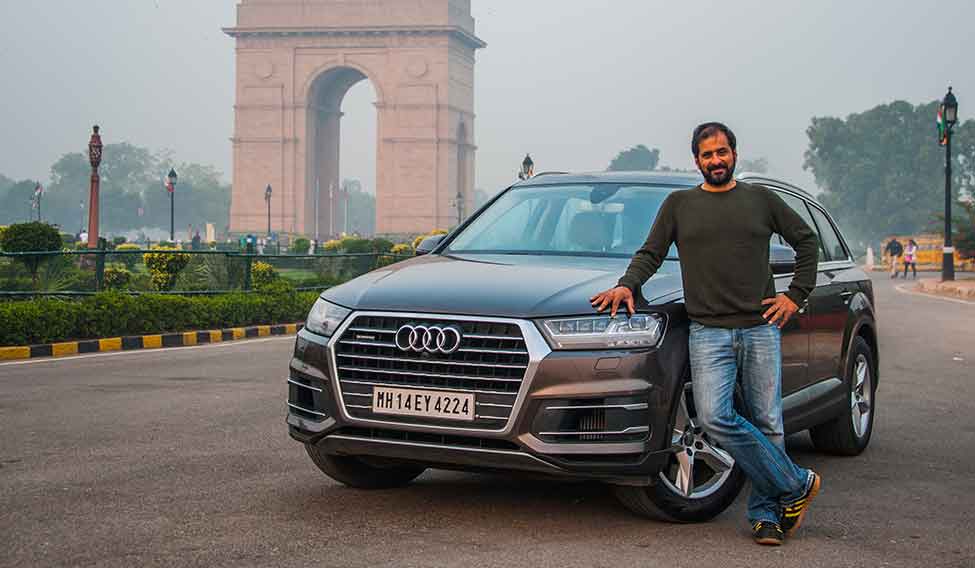 Road rage: Rishad Saam Mehta says the complete disregard of Indian drivers for traffic rules fills him with dark fantasies.
Road rage: Rishad Saam Mehta says the complete disregard of Indian drivers for traffic rules fills him with dark fantasies.
Rupani says driving barefoot is unique to Indians. “As a result, in an emergency, they cannot slam the brakes hard because the sole of the foot hurts. We Indians are good at doing many things, but driving is certainly not one of them,” he says.
Newer cars, newer technologies and better roads have brought about several changes in cars and drivers. Dr Kareeshma Wadia, a Mumbai-based eye surgeon, used to drive a Maruti Suzuki A-Star earlier and now drives a Honda Civic. “The most important criterion for me is an automatic option, though I can drive manual, too,” she says. “I prefer the effortlessness of an automatic gearbox to driving in the first or second gear all the time, and getting hassled with changing gears manually in rush-hour traffic.”
Wadia says her car has a dual mode that can shift from CNG (compressed natural gas) to petrol and vice versa. It means she can travel long distances, such as her recent 200km Mumbai-Udwada trip, in great comfort while not breaking the bank. “Ordinarily, the trip would have cost me more than Rs2,000. But, with the CNG option, I was able to do it for only around Rs600,” she says.
Remember the Premier Padmini, asks Gazder. Its steering dug into your tummy as you kept your legs in an awkward position to drive around. Today, with tilt and telescopic steering wheels and electrically adjustable seats with memory function, these discomforts have truly become a thing of the past.
Take, for instance, the cars featured at the 2016 Delhi Auto Expo, India’s largest automobile show. All of them boast technologies that focus on helping and improving the driving experience: from touchscreen navigation and driver-oriented cockpits to electronic stability control and intelligent speed assist. With the kind of technology that is brought to a driver’s fingertips, driving ought to have been safer and easier than ever before. But, it is not so in India.
Rishad Saam Mehta, author of Hot Tea Across India and the soon-to-be released Fast Cars and Fidgety Feet, says the complete disregard of Indian drivers for traffic rules frustrates and fills him with dark fantasies. He has a list of remedies, albeit fanciful, for what can be done to set things right:
* Jumping a red light: There should be a policeman and a medieval executioner, complete with curved scimitar, sharpening stone and execution block, at every red light. Offenders would be pulled out of their cars or off their bikes and beheaded. Heads should be piled up at every red light. That way, jumping the light will stop.
* Driving on the wrong side of the road: Tanks should patrol our highways and anyone driving on the wrong side should be blown to bits without warning.
* Not wearing seatbelts: Lock the offenders in a test car, without their seatbelts on. Then ram the car into a concrete wall at 80kmph. Those who survive the impact should go through it again. Continue till they are dead.
* All this should be recorded and shown in movie halls to build public awareness about how to avoid death by punishment on our roads by obeying traffic rules.
Mehta says his suggestions should be treated as a “work of humour”. “It can never be implemented,” he says. “It is a fantasy like Harry Potter or The Transformers. But just imagine: if it could be, then what?”
What is wrong with our traffic?
P.S. Pasricha, former director-general of police in Maharashtra who did his PhD in traffic management, has nostalgic memories of traffic in Bombay. “Back then, nobody used cellphones while driving,” he says. “Also, if you loved somebody, you knew better than to express your love inside a car. These days, youngsters watch a lot of action films and imitate the stunts on the road. Whether it is late at night or in the early hours of morning, young bikers and motoring enthusiasts speed away on the [Bandra-Worli] Sea Link or on the expressway. Also, look at ‘family planning’— husband, wife, two kids, a little one in the arms and an entire vegetable store ride on a motorcycle, taking full advantage of its cost-effectiveness. If Marine Drive, which was constructed 77 years ago, could be so well-made, why are our roads, which are meant to have a life of 30 to 35 years, destroyed in just 5-6 years?”
Pasricha has a word of advice for young drivers. “If we love our country, then it is our collective responsibility to ensure that people don’t mock or ridicule us. Today, 16 per cent of [road traffic] fatalities in the world happen in India, besides 6,00,000 [accident-related] injuries. It is not a good impression to give investors. They draw their impressions from our behaviour on road. So don’t be brash. Let them see our civilised behaviour and dignity.”
Says Folger, who has been in India for the past four months: “My personal observation is that you have an issue with your traffic rules. You have rules but you don’t get encouraged to obey them. When you don’t have laws that are applied, then everybody does what everybody thinks they can do, and you get away with pretty much everything.”
Nitin Dossa, executive chairman of Western India Automobile Association, says traffic fines should be hiked and conditions for obtaining a driver’s licence made stricter. “Look at how two-wheelers zigzag through traffic. They cut you off from the wrong side and enter No Entry zones frequently. The onus is now on car drivers to save two-wheeler riders,” he says.
King says he does not find two-wheeler riders to be a problem. What upsets him is the fact that very few of them wear helmets while riding. “For me, that is just insane. The first thing I would like to see is that it [wearing helmets] becomes absolutely mandatory for everyone on a two-wheeler, no questions. There has to be a strict approach and that would be a huge step in the right direction,” he says.
What worries Flynn the most is the absence of lane discipline in India. He says the Mumbai-Pune Expressway is “probably the most dangerous piece of road I have ever been on in my life”. “I came back from Pune to Mumbai on a Sunday recently, and there were four fatal accidents. A couple of them involved trucks and there was also an LCV (light commercial vehicle)…. The bottom line is that it was on a Sunday afternoon!” says Flynn.
He says truck drivers in India do not understand rules or regulations. “They fill all the lanes… and manage to get every lane blocked,” he says. “Also, people don’t drive on the outside lane. Why? Everybody is in and out [of lanes]; you get a car going on the outside, a car going on the inside and what is going to happen when they come around and don’t see the truck ahead. It’s unbelievable.”
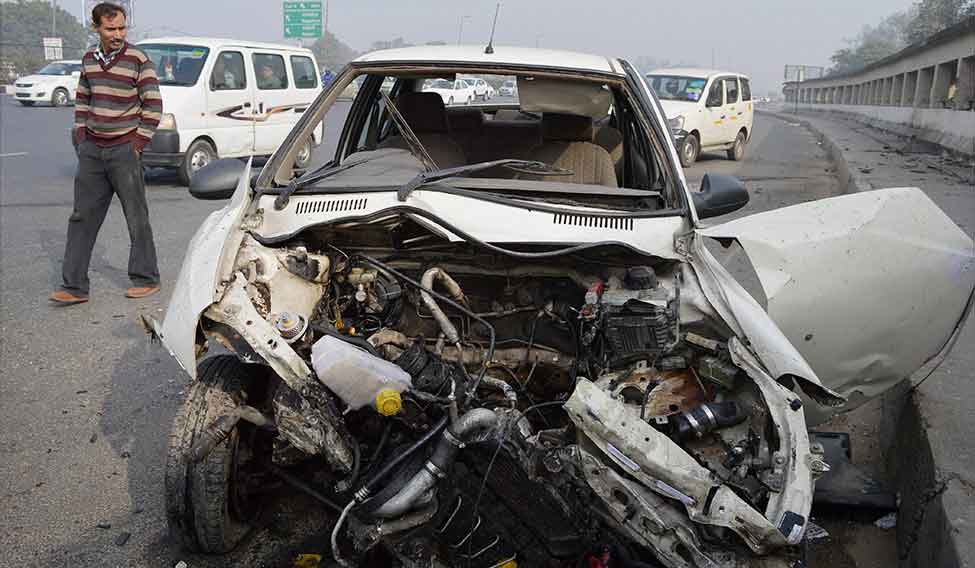 Deadly drive: The wreckage of a car on the Delhi-Gurgaon expressway | PTI
Deadly drive: The wreckage of a car on the Delhi-Gurgaon expressway | PTI
Infrastructure is a major issue. King feels that one of the challenges in Mumbai is the “quality of the tarmac”. Also, he says, the fact that many illegal speed-breakers are present across India. “As far as bumps go, people need to slow down and that causes a lot of chain reaction,” says King. “People aren’t necessarily paying attention, and that causes a real fluctuation in speeds, in fuel efficiency and pollution in general.”
Folger says India needs to deal with the infrastructure issue in an urgent manner. “If you want to speed things up, you have to build tonnes of roads,” he says. “So, now is the time to act.”
Says Flynn: “There needs to be expressway-type infrastructure. The inner cities are congested and that brings its own challenges. Some of the junction designs are such that they cause backups and, therefore, accidents.”
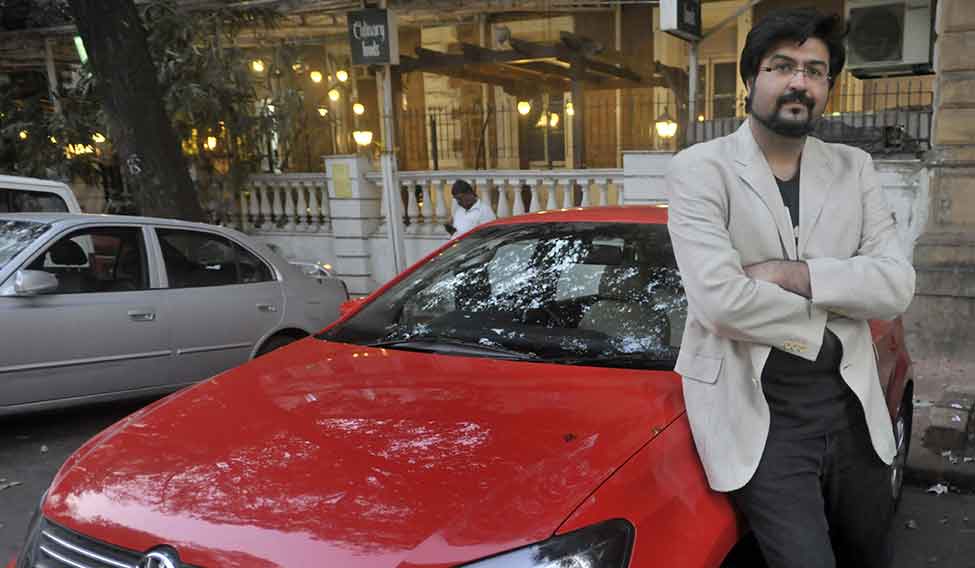 Behzad Gazder, Mumbai-based advertising professional | Janak Bhat
Behzad Gazder, Mumbai-based advertising professional | Janak Bhat
The solution
According to Flynn, the bottom line is that a driver education programme is necessary for protecting people’s lives. “There needs to be an education process and, probably, as an industry we need to support it,” he says. “But the truck industry needs to take care of itself. Educating truck drivers would halve the fatalities.”
Audi has set an example by offering chauffeur training programmes for its customers. There is also the ‘general drive experience’, a driver training programme that the company runs across the country. The programme has trained 7,000 people since its inception four years ago. “People love these driving programmes,” says King. “They surprise themselves with what these cars can do and they fully get to appreciate the technology that goes into the cars. They appreciate the basics they learn.”
As a company that sells performance cars, he says, Audi has a responsibility to educate drivers. “Anybody who buys a performance car from Audi will go through it [an education programme],” says King. “We like to call it mandatory, but obviously you can’t make it so. From our point of view, a purchase includes a specialist driver training programme at the BIC [Buddh International Circuit in Greater Noida] by expert trainers who teach drivers how to handle a car. They are very, very safe cars and have an enormous amount of assistance built into them. So it is very hard to get into trouble with an Audi car. But still, if a situation comes up where you have to react as a driver, we want people to at least be best prepared.”
King says he cannot imagine a customer not wanting to undergo the programme. “It’s a wonderful experience,” he says. “It will enhance the ownership experience. It will also let them know about the abilities of the car in a safe confined area and understand their limits, which is also very important—because accidents are often caused by human error.”
Folger believes Indians are not bad drivers. “Indians driving in the US or Germany drive like any other American or German,” he says. The driver training programme offered by Mercedes-Benz, he says, is “booked solid for months”.
Folger swears by seatbelts. “They are the most primitive safety feature you have in your car,” he says. “It is very important to buckle up properly, because if you don’t wear your seatbelt, everything else is only helpful to a fraction. Most people die because of head fractures or other issues. Buckling up really prevents that.”
In an effort to spread awareness of safe driving and to reduce the startling fatality rate on Indian roads, Mercedes-Benz has conceptualised the Safe Roads initiative. “We go in units, together with our colleagues from MBRDI [Mercedes-Benz Research and Development India], which is our development arm in Bengaluru,” says Folger. “We support this programme because we believe that we can contribute something to the overall safety on roads here.”
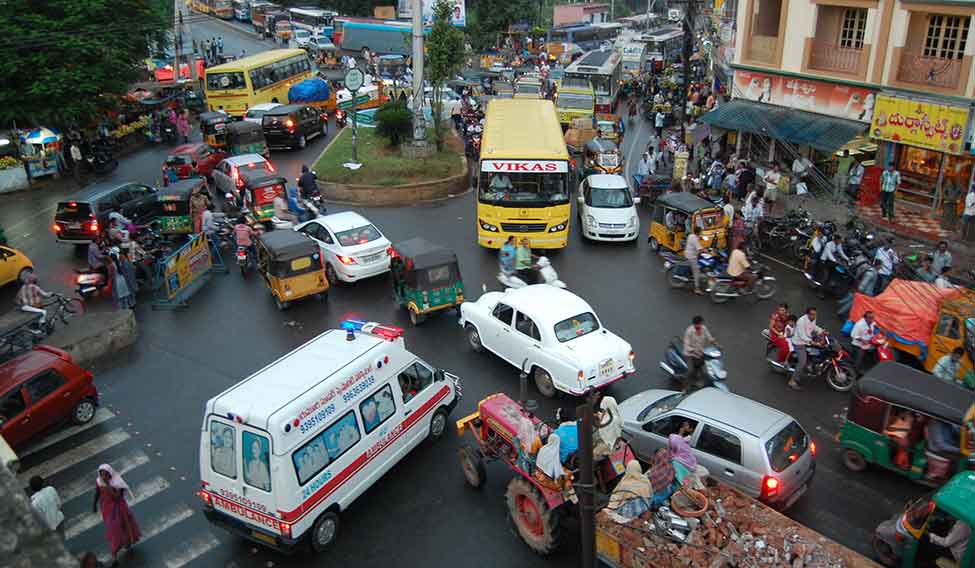 Confusion reigns: A crowded junction in Vijayawada | T. Srinivasa Reddy
Confusion reigns: A crowded junction in Vijayawada | T. Srinivasa Reddy
Industrialist Gautam Singhania, too, has been supporting programmes to ensure that Indians become great drivers. (Singhania himself has been winning accolades in racing circuits lately.) “Indians are fundamentally good drivers,” he says. “They just don’t get the opportunity to race at the right level, or go through the right training programme to get there. Take somebody like me: I never had the opportunity when I was young, but I stepped out of the box…. Really, we need a proper driver training programme here. Take somebody like Lewis Hamilton, who, at the age of four, knew that he wanted to drive Formula One and that there was a process to go through. Here, we don’t have that.”
The future of driving
Driving, as we know it, could well come to an end. “A very interesting thing is gathering pace,” says King. “Within the year, Audi will have cars that will totally drive by themselves, and will be networked internationally. The technology is there and much of the technology is already in the cars. There is the last step of getting the government and insurance companies [on board] and sorting out other legalities. Looking at it from this context, it [the technology] takes out any opportunity for accidents.”
But, until that happens, it will always be Duel Redux for Indian drivers.




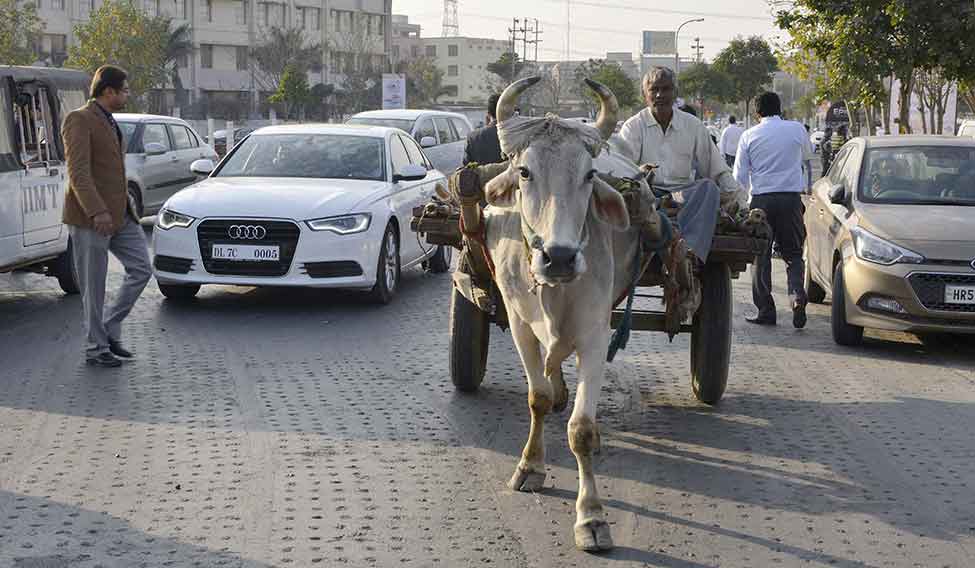







.jpg.image.234.136.jpg)

